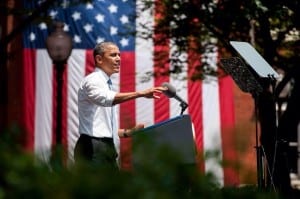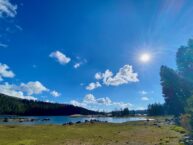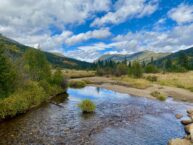President Obama spoke to the nation Tuesday at Georgetown University and laid out his vision for the steps needed to prepare for the impacts of climate change and lead the global effort to fight it –
By Glynn Wilson –
President Barack Obama, who was already guaranteed to go down in history as the first African-American president who won two-terms and passed the first law ever to regulate the for-profit health care industry, may also be remembered for taking a bold stand to combat climate change due to global warming from the burning of fossil fuels.
While the television networks mostly ignored his remarks and concentrated their coverage on a predictable ruling from a conservative Supreme Court rolling back voting rights, as well as the latest sensational developments in the whereabouts of NSA whistleblower Edward Snowden, millions of people all over the world watched the president’s major address on climate change at Georgetown University live on the Web.
“It was important for me to speak directly to your generation,” the president said to students watching in the hot summer sun, “because the decisions that we make now and in the years ahead will have a profound impact on the world that all of you inherit.”
The president led his remarks with a story about the Apollo 8 astronauts from Christmas Eve, 1968, when the first humans orbited the moon and described what they saw — a picture of earth from space that would “change the way we see and think about our world,” Mr. Obama said.
About the same time we began exploring space, scientists were studying changes taking place in the Earth’s atmosphere. Scientists had known since the 1800s that greenhouse gases like carbon dioxide trap heat, and that burning fossil fuels released those gases into the air. In the late 1950s, the National Weather Service began measuring the levels of carbon dioxide in the atmosphere, and the first signs began to emerge that rising levels of green house gases might disrupt the fragile balance that makes planet Earth so hospitable to human life.
“What they’ve found, year after year, is that the levels of carbon pollution in our atmosphere have increased dramatically,” the president said. “That science, accumulated and reviewed over decades, tells us that our planet is changing in ways that will have profound impacts on all of humankind.”
The 12 warmest years in recorded history have all come in the past 15 years. Last year, temperatures in some areas of the ocean reached record highs, and ice in the Arctic shrank to its smallest size on record — faster than most models had predicted it would.
“These are facts,” Mr. Obama said mater of factly. “The fact that sea level in New York, in New York Harbor, are now a foot higher than a century ago — that didn’t cause Hurricane Sandy, but it certainly contributed to the destruction that left large parts of our mightiest city dark and underwater.”
The potential impacts go beyond rising sea levels, he said.
“Here at home, 2012 was the warmest year in our history. Midwest farms were parched by the worst drought since the Dust Bowl, and then drenched by the wettest spring on record. Western wildfires scorched an area larger than the state of Maryland. Just last week, a heat wave in Alaska shot temperatures into the 90s,” the president said. “And we know that the costs of these events can be measured in lost lives and lost livelihoods, lost homes, lost businesses, hundreds of billions of dollars in emergency services and disaster relief.”
In fact, he said, “those who are already feeling the effects of climate change don’t have time to deny it — they’re busy dealing with it.”
Firefighters are braving longer wildfire seasons, and states and federal governments have to figure out how to budget for that, he said.
“I had to sit on a meeting with the Department of Interior and Agriculture and some of the rest of my team just to figure out how we’re going to pay for more and more expensive fire seasons,” Mr. Obama said. “Farmers see crops wilted one year, washed away the next. And the higher food prices get passed on to you, the American consumer.”
Mountain communities worry about what smaller snowpacks will mean for tourism, he said, “and then, families at the bottom of the mountains wonder what it will mean for their drinking water. Americans across the country are already paying the price of inaction in insurance premiums, state and local taxes, and the costs of rebuilding and disaster relief.”
So the question is not whether we need to act, Mr. Obama said.
“The overwhelming judgment of science — of chemistry and physics and millions of measurements — has put all that to rest. Ninety-seven percent of scientists, including, by the way, some who originally disputed the data, have now put that to rest. They’ve acknowledged the planet is warming and human activity is contributing to it,” he said. “So the question now is whether we will have the courage to act before it’s too late.”
“As a president, as a father, and as an American, I’m here to say we need to act,” Mr. Obama said. “I refuse to condemn your generation and future generations to a planet that’s beyond fixing.”
The president revealed a three-part national climate action plan.
While his administration pledged last year to reduce America’s greenhouse gas emissions by about 17 percent from their 2005 levels by the end of this decade and have doubled the electricity generated from wind and the sun, and doubled the mileage cars will get on a gallon of gas by the middle of the next decade, he said more needs to be done.
“The reason we’re all here in the heat today is because we know we’ve got more to do,” he said.
He indicated that for the first time in 18 years, America is poised to produce more of our own oil than we buy from other nations.
“We produce more natural gas than anybody else,” he said. “These advances have grown our economy … created new jobs (and) can’t be shipped overseas. And by the way, they’ve also helped drive our carbon pollution to its lowest levels in nearly 20 years.”
Since 2006, he said, no country on Earth has reduced its total carbon pollution by as much as the United States.
In his State of the Union address, Mr. Obama urged Congress to come up with a bipartisan, market-based solution to climate change, but Congress has failed to act.
“This is a challenge that does not pause for partisan gridlock,” the president said. “It demands our attention now.”
His plan involves using the executive branch agencies to cut carbon pollution.
“This plan begins with cutting carbon pollution by changing the way we use energy — using less dirty energy, using more clean energy, wasting less energy throughout our economy,” he said.
While the Clean Air Act passed Congress unanimously with the support of a Republican president 43 years ago, it took a Supreme Court ruling in recent years to rule that greenhouse gases are pollutants covered by that same Clean Air Act and a court requirement that the Environmental Protection Agency determine whether they’re a threat to public health and welfare. Four years ago, the agency determined that they are a threat to both our health and our welfare and subject to regulation.
The data shows that about 40 percent of America’s carbon pollution comes from power plants.
“But here’s the thing,” the president said. “Right now, there are no federal limits to the amount of carbon pollution that those plants can pump into our air. None. Zero. We limit the amount of toxic chemicals like mercury and sulfur and arsenic in our air or our water, but power plants can still dump unlimited amounts of carbon pollution into the air for free. That’s not right, that’s not safe, and it needs to stop.”
So the president is directing the EPA to put an end to the limitless dumping of carbon pollution from power plants and complete new pollution standards for both new and existing power plants.
Many power companies have already begun modernizing their plants and creating new jobs in the process, he said. Others have shifted to burning natural gas instead of coal.
Nearly a dozen states have already implemented or are implementing their own market-based programs to reduce carbon pollution. More than 25 have set energy efficiency targets. More than 35 have set renewable energy targets. More than 1,000 mayors have signed agreements to cut carbon pollution.
“So the idea of setting higher pollution standards for our power plants is not new,” the president said. “It’s just time for Washington to catch up with the rest of the country.”
The president addressed the concerns of big industries and their Republican representatives, who always cry wolf about government regulations crushing the economy. It started even before he began delivering his remarks at Georgetown.
House Speaker John A. Boehner issued a statement in advance of the speech saying, “These policies, rejected even by the last Democratic-controlled Congress, will shutter power plants, destroy good-paying American jobs and raise electricity bills for families that can scarcely afford it.”
But in fact, if you keep up with what’s actually happening in the country with the union workers who actually build and maintain the nation’s power plants and pipelines, they are crying out for these good jobs and are more than willing to take on the job.
“The reason I know you’ll hear those things is because that’s what they said every time America sets clear rules and better standards for our air and our water and our children’s health,” the president said. “And every time, they’ve been wrong.”
In 1970, for example, when the Clean Air Act was passed to do something about the smog choking the air in cities, the same doomsayers claimed new pollution standards would decimate the auto industry.
“Guess what,” the president asked. “it didn’t happen,” he said. “Our air got cleaner.”
In 1990, when the government took on acid rain, the doomsayers claimed electricity bills would go up, the lights would go off, businesses around the country would suffer “a quiet death.”
“None of it happened, except we cut acid rain dramatically,” Mr. Obama said. “The problem with all these tired excuses for inaction is that it suggests a fundamental lack of faith in American business and American ingenuity. These critics seem to think that when we ask our businesses to innovate and reduce pollution and lead, they can’t or they won’t do it. They’ll just kind of give up and quit. But in America, we know that’s not true. Look at our history.”
When restrictions were passed on cancer-causing chemicals in plastics and leaded fuel in our cars, it didn’t end the plastics industry or the oil industry.
“American chemists came up with better substitutes,” Mr. Obama said.
When CFCs were phased out — the gases that were depleting the ozone layer — “it didn’t kill off refrigerators or air-conditioners or deodorant. American workers and businesses figured out how to do it better without harming the environment as much.”
The fuel standards put in place a few years ago didn’t cripple automakers, he said.
“The American auto industry retooled, and today, our automakers are selling the best cars in the world at a faster rate than they have in five years — with more hybrid, more plug-in, more fuel-efficient cars for everybody to choose from,” he said. “If you look at our history, don’t bet against American industry. Don’t bet against American workers.”
The president said we use more clean energy today, more renewables and natural gas, which is supporting hundreds of thousands of good jobs.
“We waste less energy, which saves you money at the pump and in your pocketbooks,” he said. “And guess what — our economy is 60 percent bigger than it was 20 years ago, while our carbon emissions are roughly back to where they were 20 years ago.”
The president said you don’t have to take his word on climate change being a problem. More than 500 businesses, including giants like GM and Nike, issued a Climate Declaration, calling action on climate change “one of the great economic opportunities of the 21st century.”
He said Wal-mart is even working to cut its carbon pollution by 20 percent and transition completely to renewable energy.
“Wal-mart deserves a cheer for that,” the president said. “Think about it. Would the biggest company, the biggest retailer in America, would they really do that if it weren’t good for business, if it weren’t good for their shareholders?”
The president said a low-carbon, clean energy economy can be an engine of growth for decades to come.
“I want America to build that engine,” he said.
The president cautioned that we are not going to stop producing fossil fuels over night.
“Our economy wouldn’t run very well if it did,” he said. “And transitioning to a clean energy economy takes time.”
But when the doomsayers trot out the old warnings that these ambitions will somehow hurt our energy supply, he said, “just remind them that America produced more oil than we have in 15 years. What is true is that we can’t just drill our way out of the energy and climate challenge that we face. That’s not possible.”
He said our energy strategy must be about more than just producing more oil, or whether to build one controversial pipeline.
“And, by the way, it’s certainly got to be about more than just building one pipeline,” he said, acknowledging the controversy surrounding the proposal to build the Keystone XL pipeline that would carry oil from Canadian tar sands down to refineries on the Gulf of Mexico. The State Department is going through the final stages of evaluating the proposal.
“But I do want to be clear,” Mr. Obama said. “Allowing the Keystone pipeline to be built requires a finding that doing so would be in our nation’s interest. And our national interest will be served only if this project does not significantly exacerbate the problem of carbon pollution. The net effects of the pipeline’s impact on our climate will be absolutely critical to determining whether this project is allowed to go forward.”
The president said sometimes there are disputes about natural gas, but he did not back down from his plan to use it in the short term as a bridge fuel until other alternatives can be developed.
“We should strengthen our position as the top natural gas producer because, in the medium term at least, it not only can provide safe, cheap power, but it can also help reduce our carbon emissions,” the president said. “The bottom line is natural gas is creating jobs. It’s lowering many families’ heat and power bills. And it’s the transition fuel that can power our economy with less carbon pollution even as our businesses work to develop and then deploy more of the technology required for the even cleaner energy economy of the future.”
The second way to reduce carbon pollution is to use more clean energy.
“Over the past four years, we’ve doubled the electricity that we generate from zero-carbon wind and solar power,” Mr. Obama said. “And that means jobs.”
Manufacturing wind turbines that now generate enough electricity to power nearly 15 million homes, he said, and installing the solar panels that now generate more than four times the power at less cost than just a few years ago.
“I know some Republicans in Washington dismiss these jobs, but those who do need to call home — because 75 percent of all wind energy in this country is generated in Republican districts,” the president said. “And that may explain why last year, Republican governors in Kansas and Oklahoma and Iowa … helped us in the fight to extend tax credits for wind energy manufacturers and producers. Tens of thousands good jobs were on the line, and those jobs were worth the fight.”
Iowa now harnesses almost 25 percent of its electricity from the wind.

President Barack Obama walks with President Xi Jinping of the People’s Republic of China on the grounds of the Annenberg Retreat at Sunnylands in Rancho Mirage, Calif., June 8, 2013. (Official White House Photo by Pete Souza)
The president said China and Germany are going “all in” in the race for clean energy.
“I believe Americans build things better than anybody else,” he said. “I want America to win that race, but we can’t win it if we’re not in it.”
The plan calls for doubling the amount of energy generated from the wind and the sun.
The Interior Department is getting the green light to allow private companies to create enough renewable energy capacity on public lands to power more than 6 million homes by 2020.
The Department of Defense — the biggest energy consumer in America — will install 3 gigawatts of renewable power on its bases, generating about the same amount of electricity each year as you’d get from burning 3 million tons of coal.
“And because billions of your tax dollars continue to still subsidize some of the most profitable corporations in the history of the world, my budget once again calls for Congress to end the tax breaks for big oil companies, and invest in the clean-energy companies that will fuel our future,” Mr. Obama said.
A third way to reduce carbon pollution is to waste less energy in cars, homes and businesses.
The fuel standards set over the past few years mean that by the middle of the next decade, cars and trucks will go twice as far on a gallon of gas.
“That means you’ll have to fill up half as often (and) we’ll all reduce carbon pollution,” the president said.
He indicated that the energy used in U.S. homes, businesses, factories, schools and hospitals are responsible for about one-third of the greenhouse gases produced here.
“The good news is, simple upgrades don’t just cut that pollution,” he said. “They put people to work — manufacturing and installing smarter lights and windows and sensors and appliances. And the savings show up in our electricity bills every month — forever.”
Federal agencies have reduced greenhouse gas emissions by more than 15 percent since Mr. Obama took office.
“But we can do even better than that,” he said. “So today, I’m setting a new goal. Your federal government will consume 20 percent of its electricity from renewable sources within the next seven years.”
He is also encouraging private capital to get off the sidelines and get into these energy-saving investments.
By the end of the next decade, these combined efficiency standards for appliances and federal buildings will reduce carbon pollution by at least three billion tons.
“I know these standards don’t sound all that sexy,” the president said. “But think of it this way. That’s the equivalent of planting 7.6 billion trees and letting them grow for 10 years — all while doing the dishes.”
This will not get us where we need to be overnight, the president admitted.
“The hard truth is carbon pollution has built up in our atmosphere for decades now,” he said. “And even if we Americans do our part, the planet will slowly keep warming for some time to come. The seas will slowly keep rising and storms will get more severe, based on the science. It’s like tapping the brakes of a car before you come to a complete stop and then shifting into reverse. It’s going to take time for carbon emissions to stabilize.”
So there is a need to get prepared for the consequences.
The president’s plan sets out to protect critical sectors of the economy and prepare the U.S. for the impacts of climate change that cannot be avoided. Some states and cities across the country are already taking it upon themselves to get ready, he said, including Miami Beach, which is hardening its water supply against seeping saltwater.
The overwhelmingly Republican legislature in Texas voted to spend money on a new water development bank as a long-running drought cost jobs and forced a town to truck in water from the outside, the president pointed out.
New York City is fortifying its 520 miles of coastline as an insurance policy against more frequent and costly storms.
“What we’ve learned from Hurricane Sandy and other disasters is that we’ve got to build smarter, more resilient infrastructure that can protect our homes and businesses, and withstand more powerful storms,” the president said. “That means stronger seawalls, natural barriers, hardened power grids, hardened water systems, hardened fuel supplies.”
The budget he sent to Congress includes funding to support communities that build these projects, and the president’s plan directs federal agencies to make sure that any new project funded with taxpayer dollars is built to withstand increased flood risks.
The president pledged to partner with communities seeking help to prepare for droughts and floods, reduce the risk of wildfires, protect dunes and wetlands that pull double duty as green space and as natural storm barriers, and to open climate data and NASA climate imagery to the public — to make sure that cities and states assess risk under different climate scenarios and don’t waste money building structures that don’t withstand the next storm.
“I think everybody here understands, no nation can solve this challenge alone — not even one as powerful as ours,” the president said. “And that’s why the final part of our plan calls on America to lead … international efforts to combat a changing climate…. We can’t stand on the sidelines. We’ve got a unique responsibility.”
The president called for an end to public financing for new coal plants overseas, unless they deploy carbon-capture technologies or there’s no other viable way for the poorest countries to generate electricity.
“I’m directing my administration to launch negotiations toward global free trade in environmental goods and services, including clean energy technology, to help more countries skip past the dirty phase of development and join a global low-carbon economy,” the president said. “They don’t have to repeat all the same mistakes that we made.”
Cooperation has been intensified with the emerging economies of India, Brazil, and China.
“It’s a significant step in the reduction of carbon emissions,” the president said. “The actions I’ve announced today should send a strong signal to the world that America intends to take bold action to reduce carbon pollution.”
The president also used the address to seek confirmation from the Senate of his appointee to head the EPA, Gina McCarthy.
“Gina has worked for the EPA in my administration, but she’s also worked for five Republican governors. She’s got a long track record of working with industry and business leaders to forge common-sense solutions,” the president said. “Unfortunately, she’s being held up in the Senate. She’s been held up for months, forced to jump through hoops no Cabinet nominee should ever have to –- not because she lacks qualifications, but because there are too many in the Republican Party right now who think that the Environmental Protection Agency has no business protecting our environment from carbon pollution. The Senate should confirm her without any further obstruction or delay.”
The president said it is important to try to move beyond partisan politics on this issue.
“I want to be clear — I am willing to work with anybody –- Republicans, Democrats, independents, libertarians, greens -– anybody — to combat this threat on behalf of our kids. I am open to all sorts of new ideas, maybe better ideas, to make sure that we deal with climate change in a way that promotes jobs and growth,” Mr. Obama said. “Nobody has a monopoly on what is a very hard problem, but I don’t have much patience for anyone who denies that this challenge is real. We don’t have time for a meeting of the Flat Earth Society. Sticking your head in the sand might make you feel safer, but it’s not going to protect you from the coming storm. And ultimately, we will be judged as a people, and as a society, and as a country on where we go from here.”
Our founders believed that those of us in positions of power are elected not just to serve as custodians of the present, but as caretakers of the future, the president said.
“That’s what the American people expect. That’s what they deserve,” he said. “And someday, our children, and our children’s children, will look at us in the eye and they’ll ask us, did we do all that we could when we had the chance to deal with this problem and leave them a cleaner, safer, more stable world? And I want to be able to say, yes, we did. Don’t you want that?”
As he did when he first ran for office, Mr. Obama said this is not just about him or his political future. He asked for the publics’ help, again.
“I’m going to need all of you to educate your classmates, your colleagues, your parents, your friends,” he said. “Tell them what’s at stake. Speak up at town halls, church groups, PTA meetings. Push back on misinformation. Speak up for the facts. Broaden the circle of those who are willing to stand up for our future.”
The president asked for all our help to push our communities to adopt smarter practices.
“Remind folks there’s no contradiction between a sound environment and strong economic growth,” he said. “And remind everyone who represents you at every level of government that sheltering future generations against the ravages of climate change is a prerequisite for your vote. Make yourself heard on this issue.”

President Barack Obama views student projects created on laptops during a tour at Mooresville Middle School in Mooresville, N.C., June 6, 2013. (Official White House Photo by Pete Souza)
Early Reaction
Sierra Club executive director Michael Brune, whose group has already helped secure the retirement or announced retirement of 147 coal plants in the United States, said the speech marks a turning point in the nation’s energy policy.
“The president realizes that you can’t combat climate change without a direct confrontation with the fossil fuel industry,” Brune said. “What has us most encouraged by the president’s speech is he is lacing up his gloves and getting ready for that fight.”
Related Links
An Advance Look at President Obama’s Plan to Address Global Climate Change
Read the advance Fact Sheet here.















